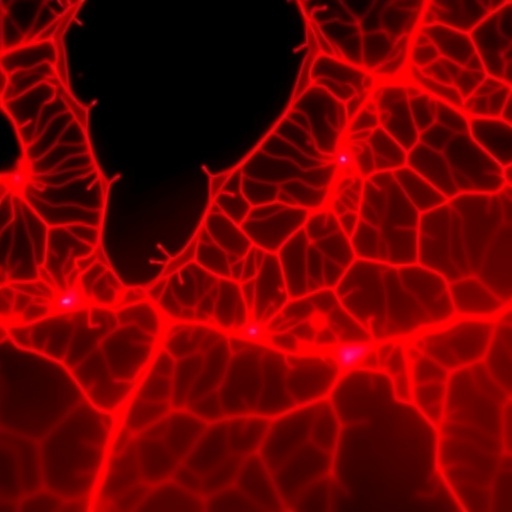MIT Chemists Pioneer Stable Boron-Based Fluorescent Molecules Emitting in the Red to Near-Infrared Spectrum
In a groundbreaking development poised to transform biomedical imaging and optoelectronics, researchers at MIT have engineered a novel class of fluorescent molecules that incorporate boron ions capable of stable light emission in the red to near-infrared (NIR) spectrum. This breakthrough not only addresses enduring challenges surrounding the stability and brightness of red fluorescent dyes but also opens up promising avenues for enhanced tumor imaging and advanced sensor technologies.
Traditional fluorescent dyes used for biological imaging primarily emit blue or green light, which unfortunately are suboptimal for deep tissue applications. The short wavelengths of visible blue and green light scatter intensely within tissues and are often overwhelmed by endogenous autofluorescence, thereby limiting the clarity and depth of imaging. Red and NIR emission, conversely, is far more desirable due to its superior tissue penetration and reduced background interference, yet commercially available red dyes suffer from poor stability and low quantum efficiency, typically on the order of only 1%.
The novel dyes synthesized by the MIT group leverage the unique photophysical properties of borenium ions—positively charged boron species with three coordinating atoms. Historically regarded as laboratory curiosities due to their extreme reactivity and air sensitivity, these ions have been rendered functionally inert and air-stable through the strategic attachment of carbodicarbene (CDC) ligands. These ligands act as robust molecular shields, preventing the borenium ion from degrading upon exposure to ambient conditions and illuminating the path toward practical application.
The team’s latest findings, recently published in Nature Chemistry, highlight the successful stabilization of these borenium ions, enabling their handling in open air without the previously requisite glovebox. One of the most striking features of these CDC-borenium complexes is their remarkable quantum yields, approaching 30% in the red emission region—an unprecedented figure that promises intensely luminous dyes rarely seen at these wavelengths. This leap is attributed to a sophisticated phenomenon called exciton coupling between the borenium cation and its paired anions, effectively tuning the electronic transitions to favor near-infrared luminescence.
Beyond photostability and brightness, these compounds exhibit unparalleled versatility in material form. The MIT researchers demonstrated the ability to fabricate the molecules into crystalline solids, films, powders, and colloidal suspensions without loss of their luminescent properties. Such flexibility paves the way for diverse technological implementations, including injectable polymer-encapsulated imaging agents designed for precise in vivo tumor visualization—a major goal in oncological diagnostics.
The implications extend beyond biomedical imaging. Due to their temperature-dependent optical responses, these stable borenium dyes can serve as molecular thermometers. This capability is particularly topical for monitoring the thermal integrity of temperature-sensitive pharmaceuticals and vaccines throughout their distribution channels. Real-time temperature mapping at the molecular scale could revolutionize quality control in medical logistics, ensuring therapeutic efficacy remains uncompromised.
Another frontier unlocked by these materials is their potential integration into next-generation organic light-emitting diodes (OLEDs), especially in the development of flexible displays and wearable electronics. The combination of red-to-NIR emission, high photoluminescence efficiency, and structural robustness makes these dyes prime candidates for organic semiconductors where color fidelity, brightness, and device longevity are critical.
The proactive approach taken by the MIT team in modifying both the borenium cation and its counter anions has set a new paradigm. While initial research stabilized the borenium core itself, the introduction and manipulation of specific anions in the CDC-borenium assembly revealed the capacity to finely modulate emission properties via electronic interactions—a molecular engineering feat that deepens our understanding of ion-pair chemistry in luminescent materials.
Future directions include extending the emission spectrum further into the NIR region by incorporating additional boron centers. Although this increases synthetic complexity and typically diminishes molecular stability, the researchers are innovating new carbodicarbene ligands to counterbalance these effects. Such advances could enable fluorescent probes with even greater tissue penetration and sensitivity, dramatically enhancing non-invasive imaging capabilities.
This exciting development stands at the intersection of inorganic chemistry, materials science, and biomedical engineering, demonstrating how fundamental research on molecular ions can lead to practical tools with immediate clinical and technological impact. As the field moves forward, these resilient boron-based dyes may serve as foundational elements in a new generation of diagnostic and optoelectronic devices.
The research was supported by the Arnold and Mabel Beckman Foundation and the National Institutes of Health, underscoring the importance of foundational funding in achieving translational scientific breakthroughs.
Subject of Research: Chemistry – Development of stable boron-containing fluorescent dyes for red to near-infrared emission
Article Title: Unlocking red-to-near-infrared luminescence via ion-pair assembly in carbodicarbene borenium ions
News Publication Date: 6 October 2025
Web References:
https://www.nature.com/articles/s41557-025-01941-6
https://pubs.acs.org/doi/full/10.1021/jacs.1c11861
Image Credits: MIT
Keywords
Chemistry, Physical sciences, Imaging, Medical imaging




